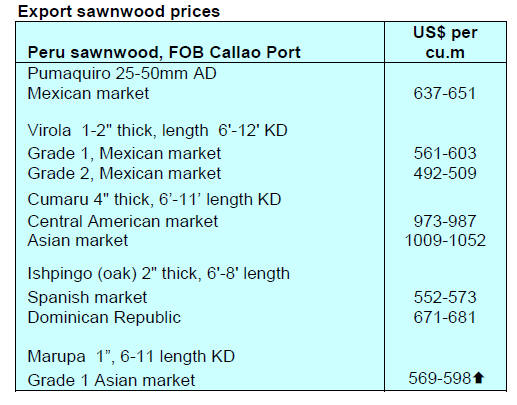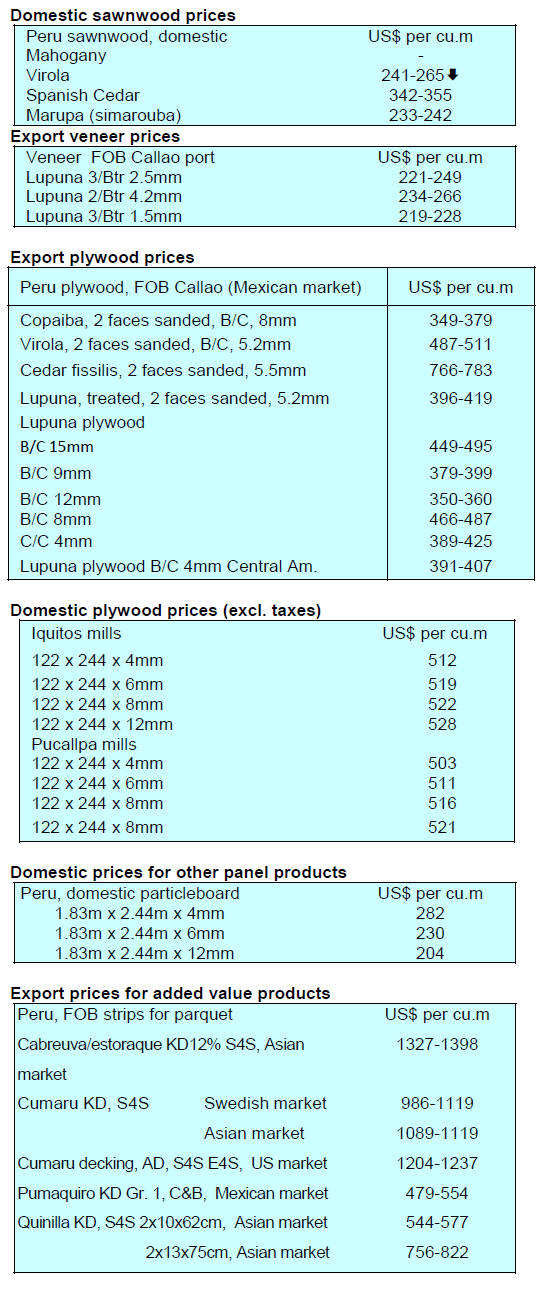4.
INDONESIA
Timber sector may be seeing a
recovery
Bambang Hendroyono, Secretary General in the Ministry
of Environment and Forestry, has reported that wood
product export figures for June are suggesting that the
timber sector may be at the beginning of a recovery phase
despite the impact of the global COVID-19 pandemic.
This view was supported by Indroyono Soesilo, Chairman
of the Association of Indonesian Forest Concessionaires
(APHI), who said looking at the trend there is optimism
that a year on year increase in export earnings from the
timber sector could be possible in the second half of the
year.
See:
https://foresthints.news/indonesias-forestry-exports-beginto-recover-despite-covid-19/
A boost to the overall export performance came from an
increase in exports to the US explained the Head of the
Indonesian Trade Promotion Center in Los Angeles, Bayu
Nugroho. The Ministry of Trade has reported that there
was an increase in furniture exports to the US in the first
five months of the year. When half year data becomes
available the full picture will become clear.
Furniture exports from Indonesia to the US between
January and May 2020 earned US$582 million well above
the US$385 million in the same period in 2019.
Indonesia's furniture exports to the US in 2019 were
recorded at US$1.04 billion, an increase of almost 30%
compared to the US$809 million in 2018.
See;
https://pressrelease.kontan.co.id/release/ekspor-furniturindonesia-ke-amerika-serikat-melonjak-513-di-tengah-pandemicovid-19
While overall the export performance was solid, APHI
Executive Director, Purwadi Soeprihanto, has expressed
concern that exports of Indonesian wood products to the
EU have not grown as much as anticipated. In trying to
explain this he said markets in the EU are very sensitive to
environmental considerations and product standards are
demanding.
He added that although Indonesia and the European Union
have concluded the Forest Law Enforcement, Governance
and Trade (FLEGT) Voluntary Partnership Agreement
(VPA) and Indonesia enforces its Timber Legality
Verification System (SVLK) Indonesian products have a
hard time competing with FSC labelled products. To
examine this he said that a joint audit was being conducted
between the SVLK and FSC certification schemes.
See:
https://industri.kontan.co.id/news/ini-penyebab-eksporproduk-kehutanan-indonesia-ke-uni-eropa-kurang-maksimal
https://industri.kontan.co.id/news/begini-kata-pelaku-industriproduk-kehutanan-soal-prospek-ekspor-uni-eropa
Furniture association reorientation to domestic market
The Indonesian Furniture and Crafts Industry Association
(HIMKI) is optimistic that the challenges faced by the
furniture industry will ease during the second half of the
year. Behind this view is the assumption that the Chinese
economy will improve which will lift demand for wood
products.
Looking to the future, HIMKI Secretary General, Abdul
Sobur, has indicated the second half of the year will
witness a transition period for the furniture sector.
He said the association plans to stimulate a change in the
orientation of the national furniture sector industry away
from a concentration on exports to one where the domestic
market is the main target to guard against any further
shocks to external demand.

5.
MYANMAR
Pandemic update
As of 25 July there were only 353 reported corona virus
cases in Myanmar and none required intensive care. The
testing capacity in the country has increased to around
2,000 daily. All returnees from overseas are required to
mandatory quarantine for 21 days and for a further for
seven days at home. International flights are closed until
31 August but relief flights to bring home citizens
continue.
Restrictions on business operations have undermined
company finances and resulted in many having to lay-off
workers. For mills that were able to operate, the slowdown
in orders from EU was and remains a problem and a
potential risk to the survival some companies. It appears
there is a growing sense in the domestic industry that the
timber trade in Myanmar has become overly politicalised
especially in the EU, the major market for Myanmar teak.
This has prompted the private sector to urge the
government to take action.
Orders from US importers have also fallen and this, it is
assumed, is because of the seriousness of the virus spread
in the US and the impact on manufacturing and sales.
Orders drying up
Myantrade, under the Ministry of Commerce, surveyed
226 export companies in the country. The survey found
that 19% of companies are experiencing a decline in
orders by up to 20% while 36% said they have not
received any orders from their buyers for the next three
months.
According to the survey, more than 50% of companies
saw a drop in orders with 18% reporting orders being
cancelled. More than half of the export companies
surveyed expect further declines in orders for the next
three months.
In related news, the Ministry of Labour, Immigration and
Population said that in June more than 140,000 workers
lost their jobs due to the closure of 5,658 micro, small and
medium-sized enterprises and 270 large factories as well
as shops and restaurants.
See:
https://www.irrawaddy.com/business/businessroundup/irrawaddy-business-roundup-28.html
Support for households
To alleviate the hardship faced by households the
government will provide K40,000 to each of the 5.4
million households with irregular incomes according to U
Zaw Htay, Director-General of the Ministry of State
Counsellor Office. In remote areas pilot mobile payments
will be tested. In April, the government provided essential
food to over 4 million families and then the government
provided K15,000 to each of the 1.4 million families who
did not get the food supplies from the government.
To fund the Covid-19 Economic Relief Plan the
government is working on acquiring US$1.5 billion in
loans from international organisations such as IMF, World
Bank and the Asian Development Bank.
Thousands of jobs in tourism sector at risk
During a recent National Tourism Development
Committee’s meeting, U Tin Let, Deputy Minister of the
Ministry of Hotels and Tourism, said there is a risk that a
large number of hotels and tourism related businesses will
not survive without help. If they collapse, he said, this
could result in around 75,000 directly employed workers
and thousands of indirect workers in the sector being
without an income.
Harvesting and transport
As is normal during the rain season from May to Oct only
pre-harvest work, such as the tree markings and road
maintenance, is undertaken. This year the harvesting target
is far below the Annual Allowable Cut (AAC).
For log hauling the Myanma Timber Enterprise (MTE) is
using private operators in some areas. MTE is very
carefully working to ensure private operators comply with
harvesting rules and regulations under the eyes of
environmental watchdogs which also ensures that MTE is
transparent in its contract assignment procedure. Some
critics do not understand well the difference between the
previous private sector logging sub-contracts and the
current new system of using the private service providers.
Effectiveness of dual currency log payment system
debated
The issues of the log export ban and the dual currency
system for log sales by the Myanma Timber Enterprise
(MTE) has again been discussed in the domestic press
(The Voice Journal).
Logs sold for the manufacture of export products must be
paid for in US dollars while logs to be used to produce
items for the domestic market only can be paid for in the
local currency, the Kyat.
The recent article pointed out that the two currency
payment system appears to contradict government
regulations and, this aside, allowing payments in local
currency could exaggerate the impact of fluctuations in
exchange rates.
Commenting on the suggestion for a single payment
system an exporter said the two currency system should be
maintained because logs in the so-called ‘conflict areas’
should be only for domestic use. If these logs are not
separated from other supplies then importers would face
problems satisfying the Due Diligence Requirements in
their market.
The article also urged a discussion on reconsideration of
the log export ban which was introduced in 2014 saying
the export of non-teak logs should be allowed because
local industries are not geared up to produce exportable
items from non-teak logs and the resumption of non-teak
log exports would be beneficial for the country.
Another miller/exporter commented the log export ban is
intended to support domestic industries secure log
supplies, something that was always a problem when log
exports were allowed.
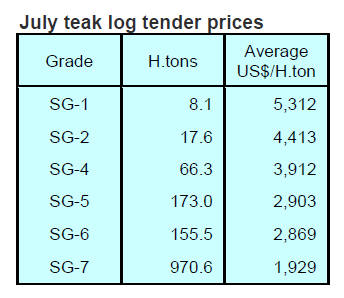
6. INDIA
Pandemic update
The Indian Ministry of Health has reported that as of 25
July there are around 1.3 million corona virus cases in the
country and 456,071 active cases. Some 849,431 people
have been treated and discharged bringing the percent
recovery to around 64%.
The government has advised against large gatherings and
has asked states and local bodies to use technology to
ensure everyone is aware of how to protect themselves.
Economy improved in June
Measures adapted to slow the spread of the virus resulted
in severe disruption of industrial production and consumer
spending during April and May but the IHS Markit
Purchasing Managers' survey for India illustrates that the
economy improved in June as restrictions were eased.
Looking ahead the survey forecasts the Indian economy
could rebound in the second half of this year.
India imposed a total lockdown in March and restrictions
were gradually eased from May. There was a sharp decline
in GDP in the second quarter of this year driving a
recession in the 2020-21 financial year.
Despite the short-term shock to the economy, foreign
investment into India remained buoyant.
See:
https://www.markiteconomics.com/Public/Home/PressRelease/b8e264c35c704290af1b7ac8d4227203
and
https://economictimes.indiatimes.com/news/economy/indicators/indian-economy-set-for-post-covid-19-rebound-as-fdi-remainsbuoyant-ihsmarkit/articleshow/77127090.cms?utm_source=contentofinterest&utm_medium=text&utm_campaign=cppst
Despite the overall dim prospects there is some
encouraging news. Analysts write “the monsoon has set
well and the Festival of trees is in full swing. Day by day
more people and also those in government are realising the
importance of green cover and ambitious projects have
been launched“.
After 25 years Public Works Department reverses ban
on timber in construction of buildings
The Indian Public Works Department under the Union
Housing and Urban Affairs Ministry, the government's
construction agency which undertakes major construction
projects on behalf of the Central Government as well as
the state governments, has changed its stance on the use of
timber in construction.
After 25 years the Public Works Department has reversed
the ban on use of timber in construction of buildings and
housing projects. This decision came about as the Ministry
of Environment, Forest and Climate Change pushed for
the change because this will increase demand for woodbased
products that would encourage investment and
create jobs.
The Ministry of Environment stated that as India has
committed to contributing to a carbon sink of 2.5-3 billion
MT through additional forest and tree cover by 2030,
raising the demand for forest products will give a boost to
efforts to expand forest cover.
See:
https://realty.economictimes.indiatimes.com/news/industry/cpwd-removes-ban-on-use-of-timber-in-construction-ofbuildings/76758331
Plans to expand domestic furniture production and
reduce imports
In the inaugural address at the India Global Week 2020, a
virtual conference organised in the UK with the theme of
Aatmanirbhar Bharat (translated to: self-reliant India) the
Indian Prime Minister stressed that the government’s
policy of self-reliance was key to protecting the country
from future economic shocks while remaining integrated
with the rest of the world.
As a follow-up the government has identified 20 sectors
where India can satisfy more of its domestic demand
through import substitution. One target for this approach
will be furniture.
Speaking at a Federation of Indian Chambers of
Commerce & Industry webinar the Minister of Commerce
and Industry highlighted the focus on expanding domestic
furniture production and reducing imports.
The Minsiter said the government has identified sectors
where India can not only meet its domestic needs but also
become globally competitive and become a global leader
by supplying to the world.
Reports suggest the government is considering restrictions
on imports of 371 items ranging from toys and plastic
goods to sports gear and furniture.
2020 survey – first half year housing sales plummeted
The near complete shutdown of all activity in the housing
and construction sectors as a result of the unprecedented
disruptions caused by the pandemic control measures has
had a devastating effect. The KnightFrank 2020 survey
shows that home sales plummeted in the first half of the
year.
Some companies managed to secure some business
through innovative online marketing, refundable deposits
and help for buyers seeking financing but, despite this, it
has been a disastrous period quarter for the market.
The impact of the lockdown resulted in over 80% declines
in sales and new starts in most regional markets.
Companies in Delhi, Chennai and Hyderabad reported
almost no sales in the second quarter. As restrictions are
being eased the problem has now become one of a
shortage of workers.
The Indian residential market has been sluggish for a few
years but of concern now is that affordable housing sector
is also showing signs of weakness and the share of
affordable housing in the overall market has fallen below
50% for the first time. The affordable housing segment
saw a strong expansion in 2014 and 2015 driven by the
governments promise of housing for all by 2022.
For more see:
https://content.knightfrank.com/research/2028/documents/en/india-real-estate-residential-office-h1-2020-indian-real-estateresidential-office-7302.pdf
Plantation teak
The trickle of teak imports has continued and traders
report no problems with domestic transport from the ports.
C&F rates for Indian ports from various other sources
continue within the same range as given earlier.
Locally sawn hardwood prices
The sawnwood markets are yet to reopen. Pre-pandemic
prices are shown below.

Myanmar teak prices
Teak log sales have resumed in Myanmar allowing millers
to build stocks ready for when demand in India recovers.
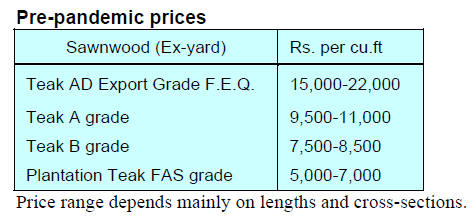
Sawn hardwood prices
Imports of timber from the US are beginning to recover
and analysts suggest there will be a growth in imports of
US hardwoods as furniture import substitution fforts take
hold. However, production at most manufacturing units is
hampered by slow demand.
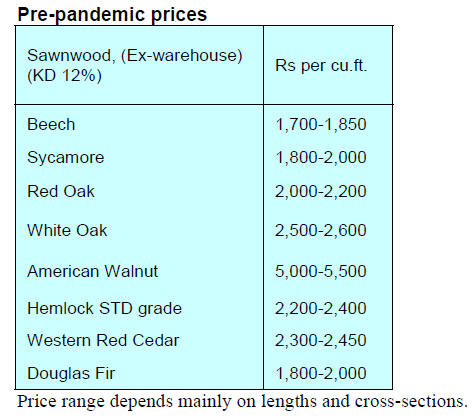
Plywood
There has been a recent focus on increasing domestic log
production and discussion have centred on how to
encourage tree planting by the States, the Central
Government, entrepreneurs and farmers. There has been
an emphasis on commercial planting of local species
which were being used but have now been depleted.
Among exotic species, eucalyptus, poplar and melia dubia
are being considered. Analysts write “if India wants to be
self-sufficient in wood products active support to increase
plantations will be necessity from the Government side.”
Although restrictions on business operations and on
domestic travel have been eased it appears many migrant
workers have not yet returned to work and this is
undermining efforts to boost industrial output.
It has been reported that in the Krishna district in Andhra
Pradesh less than 25% of workers are returning to take up
their industrial jobs which, with the weak consumer
demand has put industrial recovery at risk.
As domestic demand for plywood begins to recover the
biggest hurdle is still the availability of workers. Plywood
prices remain unchanged despite the desire of
manufacturers to lift prices.
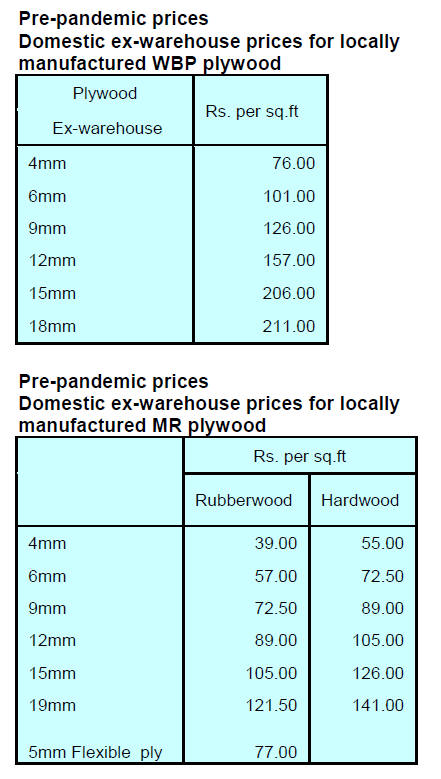
7.
VIETNAM
Acacia plantations
at risk from fungus attack
Under the “Doi moi” (renewal policy) land tenure reform,
which provided land to farmers, along with the robust
development of wood processing in the country has been a
key driver of commercial plantation development.
Immense areas of denuded hills and barren land left after
Vietnam War have been re-greened with acacia (mostly
acacia mangium and acacia hybrid – a variety of acacia
created by cross-breeding of acacia mangium and acacia
auricuriformis).
Wood harvested from over 3 million ha. of short rotation
(4–7 years) acacia and rubberwood play a vital role in
supporting the development of wood industry sector and
improvement of farmers’ livelihood.
In recent months many plantation owners have reported
the presence of disease in the acacia plantations which, it
has been identified, is caused by a leaf fungus,
Ceratocystis manginecans.
The Vietnam Academy of Forest Science (VAFS) has
warned this fungus, if not checked, could damage all
acacia species planted in Vietnam, including acacia
mangium, acacia hybrid, acacia auricuriformis and acacia
crasicarpa. The Academy noted the damage caused to
acacia plantations in Indonesia and along with the
Vietnam Administration of Forestry (VNFOREST) is
urging local authorities to take immediate action to treat
infected acacia plantations.
VNFOREST has reported on the current outbreak
specifically mentioning the infection in Tuyen Quang,
where almost 100 ha. of plantations (2019 planting) have
withered and the infection rate is over 70%. VNFOREST
has recommended the clearing and replanting. Tuyen
Quang is not the only place experiencing infection as the
disease is scattered in many places but there are no
statistics on the extent of damage.
In long term, developing disease-tolerant varieties of
acacia and diversification of planting species rather than
acacia alone are seen as possible solutions.
Export and import update
Vietnam earned just over US$5 billion from wood product
exports in the first half of this year, up 2.4% year on year
according to the Vietnam Administration of Forestry. In
June alone export earnings topped US$900 million.
In the first half of the year Vietnam imported wood
products valued at US$1.1 billion, some 8.5% down on the
first half of 2019.
Business leaders have indicated that prospect for increased
wood product exports in the third quarter this year are not
yet certain as the effect of the pandemic on businesses in
Vietnam's key markets, the United States, the European
Union and Japan is fragile.
New investment law
On 17 June 2020 the National Assembly of Vietnam
passed the new Law on investment set to take effect 1
January 2021. This replaces Decree 118/2015/ND-CP
(Decree 118).
The New Investment Law contains notable changes that
will impact investment activities in Vietnam. Further
refinement of the regulations in the law is expected.
See:
https://www.lexology.com/library/detail.aspx?g=75ce815f-0e3f-4f5f-94f8-e719fb053ac4
8. BRAZIL
Bento Gonçalves furniture cluster
feels the pain
The Brazilian furniture sector is still feeling the negative
impact of the pandemic. According to Portal Móveis de
Valor, sector revenues in May 2020 fell in the Bento
Gonçalves, Rio Grande do Sul State furniture cluster.
Revenue for the furniture cluster in the first five months of
2020 was R$656.9 million, down 7.9% compared to the
same period last year. The recent decline comes on top of
the recent decline in cumulative earnings.
Despite the negative trend the Furniture Industry
Association of Bento Gonçalves (Sindmóveis) considers
that the May figures may be a turning point, a scenario
which can be confirmed when the June data are released.
Furniture manufacturers in Rio Grande do Sul experienced
a 14% drop in revenue between January and May this
year, compared to the same period in 2019.
The furniture sector in Brazil has been for some time
struggling to recover from the weak domestic economic
growth in 2018 and 2019. In Bento Gonçalves furniture
sales did not fall last year but stagnated in real terms.
For 2020 only January and February sales were positive
that is before the pandemic impact. Sales in March and
April were the lowest in the history of the furniture
industry.
Businesses demand sustainable agenda for Amazon
A large group of business leaders have submitted a written
statement to the Vice-Presidency and the National Council
for the Legal Amazon supporting a sustainable
development agenda and for combating deforestation in
the Amazon.
The document was signed by the CEOs of about 40
companies and business groups in the industrial,
agricultural and services sectors.
In addition four organizations: the Brazilian Business
Council for Sustainable Development (CEBDS); Brazilian
Agribusiness Association (ABAG); the Brazilian Tree
Industry (IBÁ) and the Brazilian Association of Vegetable
Oil Industries (ABIOVE) were also signatories.
In the statement the executives point out that it is desirable
that the federal government gives assurances to the
Brazilian sector that some of the actions and commitments
that are presented in the statement are adopted and
implemented. Regarding the Amazon and other Brazilian
biomes the group supports the fight against illegal
deforestation.
According to IBÁ, for the business sector that operates
within the law (in compliance with national laws), there is
no inconsistency between production and preservation and
conservation. The business sector also claims that some of
the signatory companies are already developing bioeconomy
business solutions with added-value and product
traceability.
In addition to the effective fight against illegal
deforestation the following issues are also identified as
priority areas for action:
social and economic inclusion of local
communities to ensure the preservation of forests;
minimizing environmental impacts in the use of
natural resources
seeking efficiency and productivity in the
economic activities
valuing and preserving biodiversity as an integral
part of business strategies
adoption of carbon credit trading mechanisms
shifting financing and investments to a circular
and low carbon economy
incentive packages for the economic recovery
from the effects of the Covid-19 pandemic,
conditioned to a circular and decarbonized
economy.
See:
https://iba.org/eng/business-sector-demands-action-fromthe-brazilian-government-on-the-sustainability-agenda
Export update
In June 2020, Brazilian exports of wood products (except
pulp and paper) declined 8.5% in value compared to June
2019, from US$237.0 million to US$216.9 million.
The value of June pine sawnwood exports fell 13.5%
(June 2019, US$44.4 million and June 2020, US$38.4
million). In volume terms , June exports dropped 7.5%
over the same period, from 242,800 cu.m to 224,500 cu.m.
There was a sharp drop in tropical sawnwood exports in
June, 43% in volume, from 42,300 cu.m in June 2019 to
24,200 cu.m in June 2020. In terms of value June exports
also dropped 43% year on year, from US$16.0 million to
US$.2 million.
The depressing news continued with pine plywood exports
falling 11.5% in value in June 2020 in comparison with
June 2019, from US$39.3 million to US$34.8 million.
Exports volumes dropped slightly less (8.6%) over the
same period, from 159,500 cu.m to 145,800 cu.m.
The decline in exports was more pronounced for tropical
plywood where exports volumes fell 48% and export
values fell by 45% from 7,500 cu.m (US$2.9 million) in
June 2019 to 3,900 cu.m (US$1.6 million) in June 2020.
There was a 14% decline in wooden furniture exports in
June, US$44.3 million in June 2019 to US$38.1 million in
June 2020.
Furniture from China - almost half of total imports
Furniture exports from Brazil are not doing well this year,
mostly because of the pandemic and the consequent weak
global demand. The furniture trade balance improved in
the first half of the year with a surplus of almost 10%
compared to just 4.5% in the first half of last year.
Between January and June 2020 furniture imports dropped
over 20% to US$250 million compared to US$318 million
in the first half of 2019. However, imports from China fell
just 16% and accounted for more than 45% of total
furniture imports in the first half of the year.
The largest declines were in imports from countries that
export high-end quality furniture to Brazil such as
Germany (-45%), Italy (-39%) and France (-34%).
Overall, Brazil imported furniture from 64 countries in the
first half year with the top 10 shipping over 86% of the
total.
The Brazilian state that imports most furniture is São
Paulo, representing more than 40% of the total imported.
This is followed by Santa Catarina, Goiás but none
surpassed the growth in Ceará state where, year to June,
imports jumped from US$1.9 million in 2019 to US$4.2
million this year.


9. PERU
Forest authority operates virtually
In response to the pandemic remote working has become
the norm but those responsible for field activities and
inspections have faced major challenges. OSINFOR has
shifted operations to the virtual world with the help of the
USAID FOREST programme and the US Forest Service.
One of the first tasks was to find ways to maintain the socalled
“Operations Book for Forest Enabling Titles”.
Before the pandemic control measures this administrative
process was implemented on a face to face basis but it has
now been adapted with SERFOR to a remote system.
For some years SERFOR has operated a virtual training
platform in support of its field activities and last year the a
virtual version of some training programmes were
developed. With the resumption of business activities in
the timber sector the new virtual initiatives will be
maintained for the benefit the sector.
Peru – one of the hardest hit countries
The 199th anniversary of Peru’s independence was
marked on 28 July but there was little to celebrate as the
country faces the biggest challenge in recent history. Peru
has reported about 18,500 deaths from COVID-19 and
390,000 confirmed cases making it one of Latin America’s
hardest-hit nations just behind Brazil and Mexico and the
seventh highest globally.
The pandemic exposed weaknesses in Peru's healthcare
system which has prompted the President to announce
sweeping reforms. He also said the pandemic had exposed
serious underinvestment in healthcare.
There has been progressive improvement in economic
output since mid-May and the pace of decline in GDP has
slowed. The decline in GDP in April was -40% but May
data came in at -33%.
Everyone now hopes the worst economic impact has
ended. The slower pace of decline could be explained by
the start of Phase 1 of the Economic Reactivation Plan in
May when work restarted in the mining, construction and
commercial sectors.
Exports can revive the economy says ADEX
The president of ADEX, the exporters association, has
stressed the importance of exports in reviving the
economy saying, “although the external market is still
lagging, exports offer many opportunities if the right
strategies are designed”. He called for a streamlining of
investment processes and implementation of sectoral
economic support funds since each economic sector has its
own characteristics.
He concluded “Just as there is a government-togovernment
programme with the objective of overcoming
the obstacles of bureaucracy and corruption, we should
also seek new paths of action through a government-tocompany
programme to add public resources with the
executive capacity of companies.
See:
https://gestion.pe/economia/pacto-peru-anunciado-por-elpresidente-vizcarra-debe-convocar-a-todos-los-actores-del-paissenala-adex-nndc-noticia/
In related news, ADEX has said in March, April and May,
when pandemic isolation measures were in effect, 2,282
Peruvian companies stopped exporting. In the timber
sector those most affected were micro-enterprises as well
as 255 small companies, 8 medium-sized companies and
48 large companies. The micro and small sized enterprises
are in urgent need of assistance, said the president of
ADEX.
